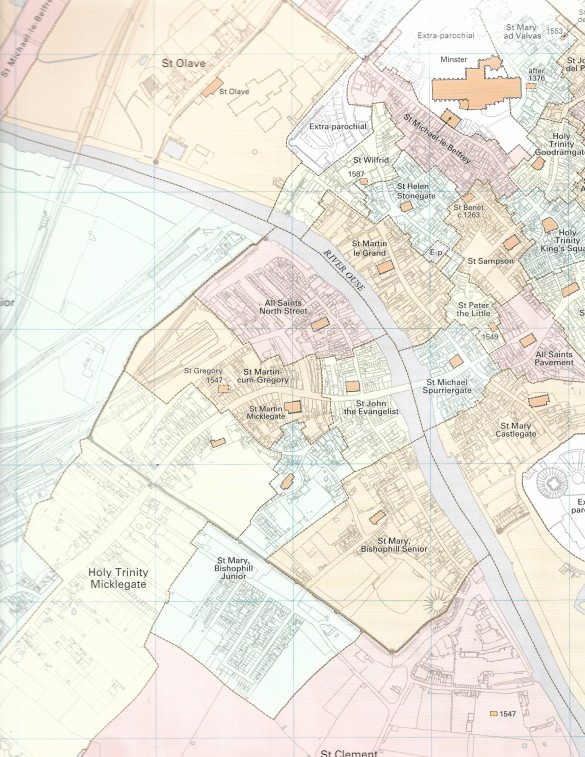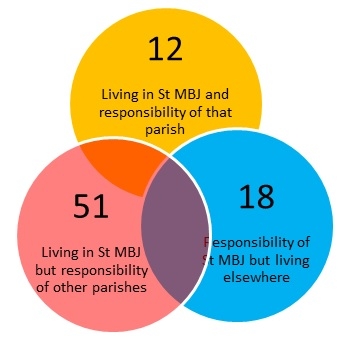Making Ends Meet: exploring mid-nineteenth century poverty in our area
Latest update report on our project August 2019
Our research project is exploring mid-nineteenth poverty locally, focusing on the St Mary Bishophill Junior (SMBJ) parish during the period 1839-43. This includes streets outside the City Walls such as Nunnery Lane, Dale Street, Dove Street and Swann Street.
We examine the role of outdoor relief - publicly-financed poor relief - distributed in kind or in money (or in a combination of both). This allowed poor people to remain in their own homes.
We looked at applications for relief in the quarter ending June 1841 and chose this period to tie in with the census held on 6 April 1841, which will be relevant in subsequent posts. From the Poor Law Union (PLU) Weekly Outdoor Relief Lists held at York Explore we identified 81 applications. (There were a total of 91 names recorded, because where a man’s application and payment included his wife, her name, year of birth and classification were shown separately. There were ten instances of this sort but all percentages are based on 81 applications). We analysed the data by settlement (responsible parish), gender, age, PLU classification and dependent children.
From the British Historic Towns Atlas, Volume V, York, © Historic Towns Trust & York Archaeological Trust 2015
Settlement and removal
Following the 1834 Act the operation of the Poor Law became the responsibility of the York Poor Law Union (PLU), which covered 80 parishes. Decisions on relief were delegated by the Board of Guardians to the Relieving Officer, at this time Richard Leaf. Each parish was responsible through the parish poor rate for meeting the costs of those paupers who had legal settlement in the parish.
Settlement could be conferred by birth, marriage, residence in an area for a particular length of time, employment, or through various property qualifications. People applying for relief without being legally settled in the parish in which they were claiming could be removed to their ‘home’ parish, but there is no evidence of this in these records. Instead there seems to have been a financial reckoning, where parishes were held responsible for the costs of their settled poor living in other parishes. The consequence of this way of handling relief meant that a particular parish was not responsible for all people living with its boundaries BUT did have responsibility for many people living elsewhere.
30 applicants have legal settlement in SMBJ but only 12 (14.8%) are also living in the parish. Whilst this suggests a degree of mobility, this should not be overstated as all bar four addresses lie within the city itself.
Breakdown by parish with responsibility for maintenance |
Number |
% |
All Saints, North Str |
7 |
8.6 |
All Saints, Pavement |
1 |
1.2 |
Holy Trinity, King's Court |
3 |
3.7 |
Holy Trinity, Micklegate |
10 |
12.3 |
Minster Yd with Bedern |
1 |
1.2 |
St Crux |
4 |
4.9 |
St Cuthbert |
1 |
1.2 |
St John Delpike |
1 |
1.2 |
St John Micklegate |
5 |
6.2 |
St Martin cum Gregory |
3 |
3.7 |
St Martin le Grand |
1 |
1.2 |
St Mary Bishophill Jnr |
30 |
37.0 |
St Mary Bishophill Snr |
2 |
2.5 |
St Mary Castlegate |
2 |
2.5 |
St Michael Spurriergate |
1 |
1.2 |
St Olaves |
2 |
2.5 |
St Peter the Little |
3 |
3.7 |
St Sampson |
1 |
1.2 |
St Saviour |
2 |
2.5 |
Out township |
1 |
1.2 |
|
|
81 |
100.0 |
Reasons for applying
The classification of claimants for relief is set out below and uses terms which might cause offence today (for example lunatic, idiot, vagrant) but would have been unexceptional at the time.
Q/E June 1841 |
POOR LAW UNION CLASSES |
|
|
|
|
|
No. of class |
Non Able Bodied |
Male |
Female |
Plus wives incl in husbands' appln |
Child |
% |
1 |
Aged, infirm, partially or wholly disabled |
15 |
17 |
5 |
NA |
39.5 |
2 |
Orphans, foundlings, and children of women re-married (but only of widows married before the passing of the Poor Law amendment Act ) |
NA |
NA |
NA |
4 |
4.9 |
3 |
Illegitimate children under 16, without their mothers |
NA |
NA |
NA |
15 |
18.5 |
4 |
Insane persons, lunatics, and idiots |
None |
None |
None |
NA |
|
|
|
Able bodied |
|
|
|
|
|
6 |
Widows, and women whose husbands have deserted them, or have been transported, having a child or children under 16 dependant on them |
NA |
14 |
NA |
NA |
17.3 |
7 |
On account of sickness or accident |
1 |
4 |
1 |
NA |
6.2 |
8 |
Out of work, and other causes |
7 |
3 |
4 |
NA |
12.3 |
9 |
Vagrants and paupers not belonging to any Parish of the Union |
None |
1 |
None |
NA |
1.2 |
|
|
Totals |
23 |
39 |
|
19 |
|
23 adult applicants were male (28.4%), 39 were female (48.1%), and 19 were child applicants under the age of 16 (23.5%). In looking at the circumstances which lead to the claim, three groups accounted for four of every five claims - aged or infirm (39.5%), children - orphans or illegitimate (23.4%) and widows or deserted wives (17.3%).
What was the age/gender profile of applicants?
Breakdown of applicants by age |
|
|
|
|
|
|
Male |
Female |
Children |
% |
under 10 |
|
|
11 |
13.6 |
10-15 |
|
|
7 |
8.6 |
16-20 |
0 |
1 |
|
1.2 |
21-30 |
0 |
3 |
|
3.7 |
31-40 |
2 |
6 |
|
9.9 |
41-50 |
3 |
8 |
|
13.6 |
51-60 |
4 |
4 |
|
9.9 |
61-70 |
5 |
7 |
|
14.8 |
71-80 |
6 |
7 |
|
16 |
over 80 |
2 |
1 |
|
3.7 |
Age not shown |
1 |
3 |
|
4.9 |
Totals |
23 |
40 |
18 |
|





